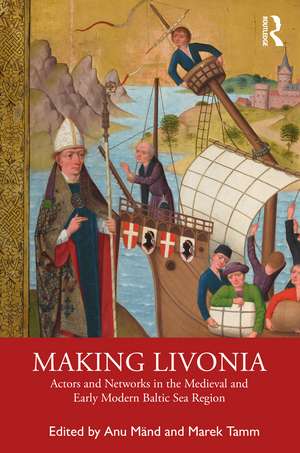Making Livonia: Actors and Networks in the Medieval and Early Modern Baltic Sea Region
Editat de Anu Mänd, Marek Tammen Limba Engleză Paperback – 3 iul 2020
This volume aims to study these interplays and explores the history of Livonia by concentrating on various actors and networks from the late twelfth to the seventeenth century. But, on a deeper level, the goal is more ambitious: to investigate the foundation of an increasingly complex and heterogeneous society on the medieval and early modern Baltic frontier – ‘the making of Livonia’.
| Toate formatele și edițiile | Preț | Express |
|---|---|---|
| Paperback (1) | 374.20 lei 6-8 săpt. | |
| Taylor & Francis – 3 iul 2020 | 374.20 lei 6-8 săpt. | |
| Hardback (1) | 1008.35 lei 6-8 săpt. | |
| Taylor & Francis – 3 iul 2020 | 1008.35 lei 6-8 săpt. |
Preț: 374.20 lei
Nou
Puncte Express: 561
Preț estimativ în valută:
71.60€ • 78.02$ • 60.34£
71.60€ • 78.02$ • 60.34£
Carte tipărită la comandă
Livrare economică 24 aprilie-08 mai
Preluare comenzi: 021 569.72.76
Specificații
ISBN-13: 9780367481285
ISBN-10: 0367481286
Pagini: 364
Ilustrații: 38
Dimensiuni: 156 x 234 x 32 mm
Greutate: 0.56 kg
Ediția:1
Editura: Taylor & Francis
Colecția Routledge
Locul publicării:Oxford, United Kingdom
ISBN-10: 0367481286
Pagini: 364
Ilustrații: 38
Dimensiuni: 156 x 234 x 32 mm
Greutate: 0.56 kg
Ediția:1
Editura: Taylor & Francis
Colecția Routledge
Locul publicării:Oxford, United Kingdom
Cuprins
Introduction: Actors and Networks in the Medieval and Early Modern Baltic Sea Region Part 1: Early Making of Livonia (Thirteenth–Fourteenth Centuries) 1. Mission and Mobility: The Travels and Networking of Bishop Albert of Riga (c. 1165–1229) 2. Political Centres or Nodal Points in Trade Networks? Estonian Hillforts Before and After the Thirteenth-century Conquest 3. Visual Performances of Power in the Period of Danish Crusades 4. Neophytes as Actors in the Livonian Crusades 5. Politics of Emotions and Empathy Walls in Thirteenth-Century Livonia 6. Donating Land to the Church: Topos as a Legal Argument in Thirteenth-Century Livonia 7. Mobility of the Livonian Teutonic Knights 8. Manuscript Fragments as Testimonies of Intellectual Contacts between Tallinn and European Learning Centres in the Thirteenth and Fourteenth Centuries Part 2: Late Making of Livonia (Fifteenth–Seventeenth Centuries) 9. City Scribes and the Management of Information: The Professionalization of a Transgenerational Agency and Its Agents in Tallinn (c. 1250–1558) 10. Cistercian Networks of Memory: Commemoration as a Form of Institutional Bonding in Livonia and Beyond During the Late Middle Ages 11. The ‘Hanseatic’ Trade of the Finnish Skalm Family in the Fifteenth and Early Sixteenth Centuries 12. Merchants as Political, Social and Cultural Actors: Tallinn Burgomaster Hans Viant (d. 1524) 13. Mintmasters as the Nodes of the Social and Monetary Network: The Life and Career of Paul Gulden (c. 1530–93) 14. Self-Representation and Social Aesthetics: Wealthy Tallinn Burgher Homes in the Early Modern Period Conclusion: From Vineyard of the Lord to Outpost of Empires: Actors and Networks in the Conquest, Government and Society of Livonia (Twelfth–Sixteenth Centuries)
Notă biografică
Anu Mänd is Head of the Centre for Medieval Studies at Tallinn University.
Marek Tamm is Professor of Cultural History at Tallinn University.
Marek Tamm is Professor of Cultural History at Tallinn University.
Recenzii
"This volume is successful in both advancing the history of Livonia and in inspiring one to think more widely about actors and networks on other medieval frontiers of northern Europe; that is highly praiseworthy."
Matthew F. Stevens, Zapiski Historyczne
Matthew F. Stevens, Zapiski Historyczne
Descriere
This volume explores the history of Livonia by concentrating on various actors and networks from the late twelfth to the seventeenth century.
